Porcelain Insulator News
by Elton Gish
Reprinted from "Crown Jewels of the Wire", July 2001, page 8
There have been some rather notable porcelain insulators reported over the
past two or three years, but we have failed to report them in PIN until now. I
apologize to those who reported the new styles for being so late putting them in
PIN. The four new unipart styles reported this month are early classic styles.
Two of the four are glazeweld styles. For those of you not familiar with
glazewelding, it is the process whereby two or more shells are glazed, nested
together, and fired in a kiln until the shells are fused together effectively
making them one unipart insulator. It was originally thought that some Imperial
insulators were made by glazewelding, but we now know that Imperial never used
that technique. A very detailed chapter about Imperial Porcelain Works, Fred
Locke's use of glazewelding, and the resultant patent infringement law suits
brought by Thomas over the Boch patented "glazefilling" process can be
found in my book, Fred M. Locke: A Biography. "Glazefilling" is a
variation on glazewelding whereby extra glaze is added to fill all the gaps
between the shells.
Hugh Barbour reported a new style of Imperial similar to the fairly common
U-935. I don't remember the last time we had a new style of Imperial insulator
reported - surely over 10-15 years ago. So, it is with great excitement that I
assign U-935C to Hugh's insulator. There are always doubts whether a reported
new style of classic insulator is actually a new style. The manufacturing
process at the turn of the century was crude so you have to allow for variations
in trimmer operations, which cut the profile of the insulator. In this case, it
was much more than profile differences. The cable groove was obviously much
larger which could only have been made through modifications of the mold. So,
once I saw a photograph of this new Imperial, it was fairly obvious that it
required a new U-number. U-935 is shown on the following page for comparison.
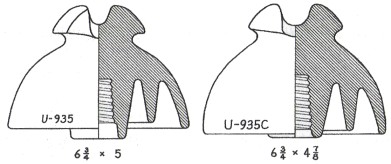
Hugh found the white U-935C in British Columbia. He has seen many white
U-935's and brown U-746's all made by Imperial. All of those have the Imperial
crown logo and other markings with manufacturing dates from 1897 to the early
1900's. U-935 struck him as quite different. It does not have the Imperial crown
logo or a manufacturing date. It is marked on opposite sides with the earliest
Imperial marking:
MANUFACTURED BY
IMPERIAL PORCELAIN WORKS
TRENTON, N.J.
Imperial first used the crown logo on July 1, 1897, and all white insulators
made after that date have both the crown logo and the manufacturing date. So,
I'm certain that U-935C was made before July 1, 1897. It is very likely that it
was the forerunner of U-935. As a side note, we know that U-746 was designed by
strengthening the crown of U-935, and it quickly became the industry standard
known as the "Redlands" insulator. Several companies made the
"Redlands" insulator. All the details of this can be found in my new
book, Multipart Porcelain Insulators-2nd edition.
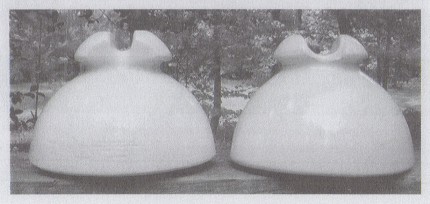
U-935 (left) and new style U-935C
(right) made by Imperial Porcelain Works.
It is rare indeed when a new glazeweld style is reported. Marty Caverly (NIA
#6918) found a new glazeweld style that looks like a 2-part multipart and it has
a lily-shell bottom skirt, too. It has been assigned U-965. He found it in an
old Michigan collection.
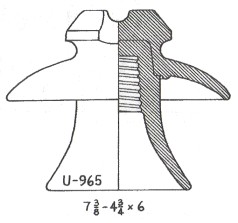
There is a half dollar sized flake chip on the bottom
skirt that someone filled in with what appears to be J-B Weld. The top skirt is
dark tan with drippy mottling on one side. The bottom skirt is unique in that
the top third is dark tan and the bottom two-thirds is light tan with darker
drips. There is a raised ring formed under the top skirt around the glazeweld
joint. This was a common practice before 1910 and it was carried into cemented
multipart styles for the apparent purpose of strengthen the joint. From the
glaze characteristics, I feel certain that it was made by the Lima Insulator Co.
in Lima, NY that was in business only from 1904 to late 1908. Fred Locke
secretly owned Lima since he was forbidden by contract from competing with Locke Insulator Mfg.
Co. after he left that company in 1904. Lima, NY is near the Locke plant and
Fred Locke's home in Victor.
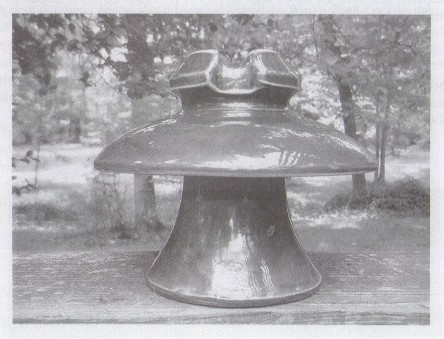
Unmarked 2-part Lima glazeweld U-965 is unique.
Charles Bibb (NIA #6097) reported a new style of Fred Locke similar to U-675.
This new style has been assigned U-675A, and, unlike U-675, it is not a
glazeweld. No U-675 has been reported with a manufacturing date after March
1901. Fred Locke developed a non-glazeweld style, U-669, which was first
produced on April 24, 1900 (a specimen with hand-applied scratched marking
exists attesting to this date). It was cataloged as No. 297, but did not appear
in his No. 5 catalog (June 1900) or his No.6 catalog (1902). The 1902 catalog
did show an almost identical style as No. 298. All U-669's have the #6-2 marking
and 1901 manufacturing dates after April. I feel sure U-675 was phased out and
eventually replaced with U-669, which was produced until a fire destroyed the
entire factory in January 1902. So, when was U-675A produced?
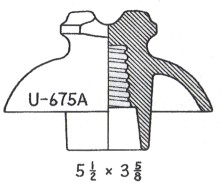
All but the smaller Fred Locke insulators made before the fire had either one
of various 4-date markings or the #6-2 incuse marking and were also marked with
manufacturing dates from 1900 to 1901. After the fire, single date markings were used and the earlier #6-2 marking was replaced with the
#6-1 marking., The #7-1 marking came later in 1902. U-675A has the #1-8
marking and the glaze color is dark speckled tan. U-675A probably replaced U-669
after the factory was rebuilt and returned to production in March 1902. The
darker glaze color of this U-675A specimen also confirms a later production.
Robert Winkler reported seeing at least one U-675A in an interurban railroad
museum in Indiana along with examples of U-669. Apparently both styles were used
in the area.
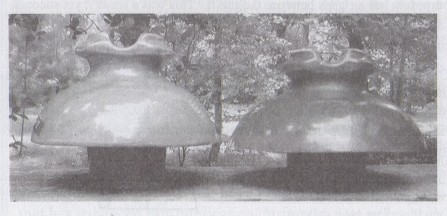
Fred Locke U-669 (left) compared to smaller U-675A (right).
Robin Harrison (NIA #3911) reported the next new Fred Locke style, U-675B. The
color appears to be white, but the glaze is extremely rough as if it had been
exposed to a severe environment. The U-675B is similar to U-675 (slight curvature
to the skirt) only larger and it is a 2-part glazeweld. This basic style was
cataloged in Fred Locke's 1902 catalog as No. 303; however, the catalog said it
was "Made in One Piece". The No. 303 has a more rounded skirt like
U-669 and U-675A. Robin's U-675B was probably made in late 1901 before Fred lost
the final round in the Boch patent case.
All of the glazeweld styles Fred Locke made prior to losing the Boch patent
infringement case were actually considered by the courts as having been made by
the "glaze filled" process. That process intended to fill all gaps
between the two shells with glaze - precisely the intent of the Boch patent and
why it was determined that Fred Locke infringed. When that decision was final,
Fred Locke quickly filed patent applications for a series of glazeweld patents.
One patent called for dipping up extra glaze (not poured in), one poured in
molten glaze (definitely not practical), and one purposely left air gaps between
the shells. This was a sneaky, yet successful, way to avoid the Boch patent.
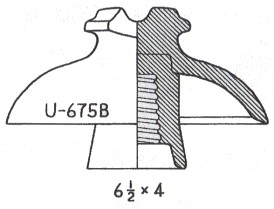
U-675, U-675B, and all the various under-glaze ink marked Fred Locke styles
had some extra glaze applied when the shells were put together. Interestingly,
the 1902 catalog noted "Made in One Piece" on each style that was
previously made by "glazefilling" and obviously now forbidden from using that
process. U-926A was specifically shown in Fred Locke's patent for leaving air
gaps in the glazeweld joint. That style and others made by this "new"
process were shown in the 1902 catalog as "Patented". Another
interesting feature to note about U-675B is the bottom skirt being flared
similar to U-955.
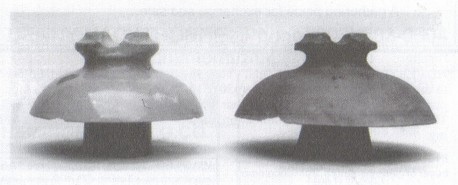
Fred Locke U-675 (left) compared to larger U-675B (right).
| 